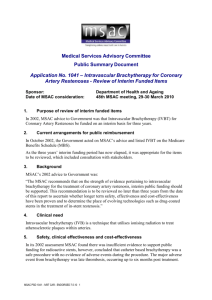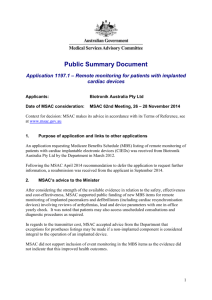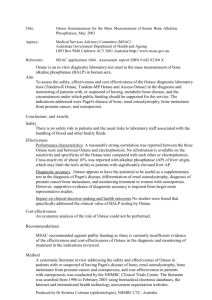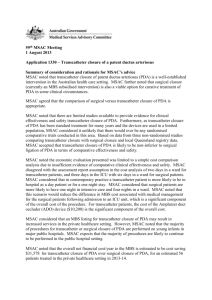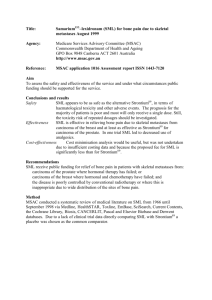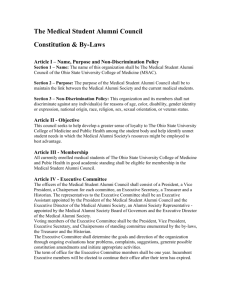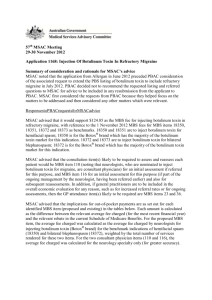Word 132 KB - the Medical Services Advisory Committee
advertisement
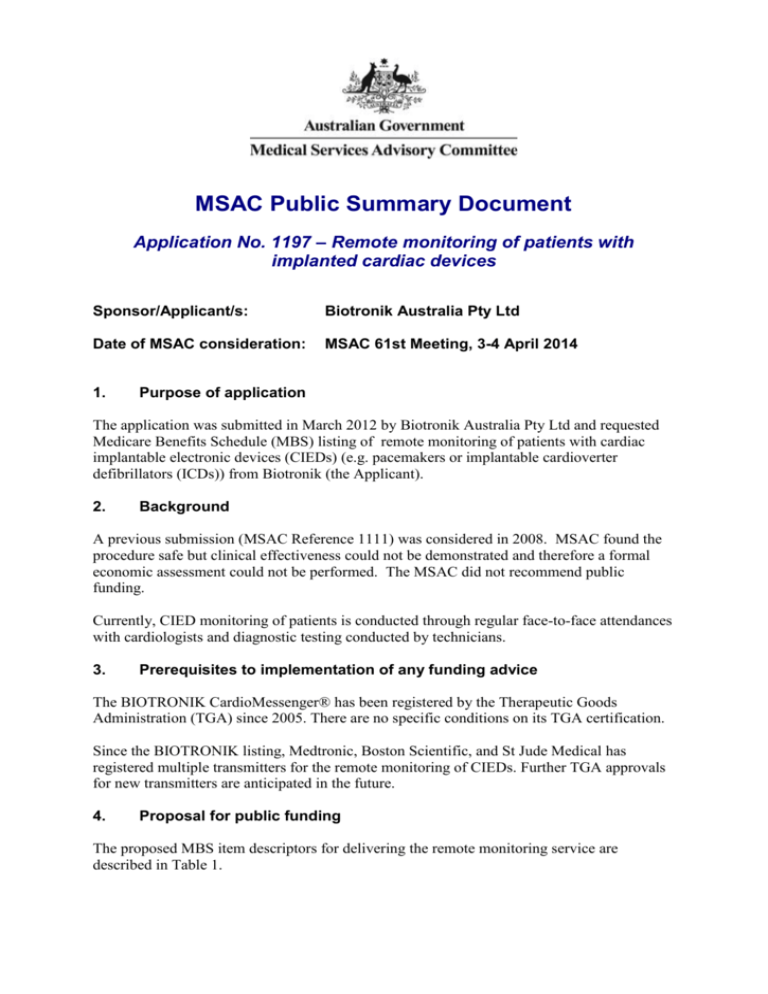
MSAC Public Summary Document Application No. 1197 – Remote monitoring of patients with implanted cardiac devices Sponsor/Applicant/s: Biotronik Australia Pty Ltd Date of MSAC consideration: MSAC 61st Meeting, 3-4 April 2014 1. Purpose of application The application was submitted in March 2012 by Biotronik Australia Pty Ltd and requested Medicare Benefits Schedule (MBS) listing of remote monitoring of patients with cardiac implantable electronic devices (CIEDs) (e.g. pacemakers or implantable cardioverter defibrillators (ICDs)) from Biotronik (the Applicant). 2. Background A previous submission (MSAC Reference 1111) was considered in 2008. MSAC found the procedure safe but clinical effectiveness could not be demonstrated and therefore a formal economic assessment could not be performed. The MSAC did not recommend public funding. Currently, CIED monitoring of patients is conducted through regular face-to-face attendances with cardiologists and diagnostic testing conducted by technicians. 3. Prerequisites to implementation of any funding advice The BIOTRONIK CardioMessenger® has been registered by the Therapeutic Goods Administration (TGA) since 2005. There are no specific conditions on its TGA certification. Since the BIOTRONIK listing, Medtronic, Boston Scientific, and St Jude Medical has registered multiple transmitters for the remote monitoring of CIEDs. Further TGA approvals for new transmitters are anticipated in the future. 4. Proposal for public funding The proposed MBS item descriptors for delivering the remote monitoring service are described in Table 1. Table 1: Proposed MBS Item Descriptors Category 2 – Diagnostic procedures and investigations MBS item TBC IMPLANTED PACEMAKER, (including Cardiac Resynchronisation Pacemaker) REMOTE MONITORING involving reviews (without patient attendance) of arrhythmias, lead and device parameters and one in-office check in a period of 12 consecutive months. Fee: $192.86 MBS item TBC IMPLANTED DEFIBRILLATOR, (including Cardiac Resynchronisation Defibrillator) REMOTE MONITORING involving reviews (without patient attendance) of arrhythmias, lead and device parameters and one in-office check in a period of 12 consecutive months. Fee: $282.95 MBS item TBC IMPLANTED PACEMAKER TESTING indicated by remote monitoring involving electrocardiography, measurement of rate, width and amplitude of stimulus including reprogramming when required, not being a service associated with a service to which item 11718 or 11721 applies. Fee: $66.86 MBS item TBC IMPLANTED DEFIBRILLATOR TESTING indicated by remote monitoring involving electrocardiography, measurement of rate, width and amplitude of stimulus including reprogramming when required, not being a service associated with a service to which item 11718 or 11721 applies. Fee: $94.75 5. Summary of Consumer/Consultant Feedback The Electrophysiology and Pacing Council of the Cardiac Society of Australia and New Zealand support this application, noting that remote monitoring may be particularly applicable to Australia given its geography and difficulty in achieving equitable access for medical care in many regional, rural and remote areas. 6. Proposed intervention’s place in clinical management The proposed intervention will be used in place of current in office diagnostic services. However, there will still be a need for unscheduled in-office visits. 7. Comparator The primary comparator is regular in-office (diagnostic) testing conducted by a cardiologist and / or technician on behalf of a cardiologist (currently MBS items 11718, 11721 and 11727). MSAC considered this was appropriate but noted that in-office diagnostic testing of the device is likely to be managed by a technician on behalf of the cardiologist. 8. Comparative safety The evidence is based on 10 randomised controlled trials (RCTs) that collectively enrolled more than 1,800 pacemaker patients and almost 17,000 recipients of ICD/CRT. These 10 pivotal RCTs included seven studies in patients with ICD/CRT (i.e. ICD, with or without CRT) and three studies in patients with pacemakers. The efficacy and safety outcomes reported for these populations have been presented separately for ICD/CRT and pacemaker recipients. Patients with ICD/CRT Results of the TRUST and ECOST trials suggested that the rates of adverse events, and events requiring hospitalisation or emergency department visits were similar between remote monitoring and conventional care. One study (IN-TIME) reported a significant association between remote monitoring and increased patient survival. From the IN-TIME trial, 10 patients assigned to the remote monitoring arm and 27 patients in the standard care arm died during follow-up. Patients with pacemaker The COMPAS trial reported that pacemaker patients monitored remotely required fewer inclinic visits per annum compared to standard care. This study also observed that, despite major adverse events rates that were broadly consistent across both management strategies, subjects in the remotely monitored group experienced a lower rate of hospitalisation compared to standard care. Based on the overall results, the application noted that remote monitoring: leads to a reduction in overall in-office follow-up visits; is as safe as conventional follow-up, demonstrated by outcomes including adverse events, mortality, inappropriate shocks, hospitalisations and emergency department visits; and reduces all-cause mortality in patients with ICD/CRT. The Department noted that the safety of remote monitoring has not been adequately established in patients with NYHA class IV heart failure. Based on the evidence presented, MSAC considered that remote monitoring is as safe as conventional follow-up, demonstrated by outcomes including adverse events, mortality, inappropriate shocks, hospitalisations and emergency department visits. MSAC noted the small number of NYHA class IV patients in the TRUST and CONNECT trials and that the safety of remote monitoring in this subgroup of patients had not been demonstrated. 9. Comparative effectiveness The application indicated that, based on the IN-TIME study, remote monitoring has the potential to improve quality of life in patients. The Department noted that the evidence does not support the conclusion that the proposed remote monitoring MBS listing will lead to improved clinical outcomes for patients, and that at most remote monitoring is non-inferior compared to conventional monitoring. MSAC considered that overall remote monitoring leads to a reduction in overall in-office follow-up visits. MSAC noted that the IN-TIME trial was the only study presented which demonstrated a survival benefit for remote monitoring over conventional monitoring although this study compared regular in office consultation with regular in office consultation plus remote monitoring. MSAC agreed that although remote monitoring was not associated with any increase in patient deaths, there was insufficient evidence to conclude that remote monitoring (as per the proposed MBS listing) is associated with any survival benefit. 10. Economic evaluation The primary economic evaluation presented a cost-minimisation approach based on clinical non-inferiority. The cost-minimisation analysis for the ICD/CRT patient population was estimated to be costsaving (annual costs being $19.51 lower than conventional follow-up) and to be marginally cost-saving for the pacemaker population (annual costs being $0.71 lower than conventional follow-up). In both patient populations, the cost of the remote monitoring service is offset by the cost-savings from the reduction in office visits. The application also presented an alternative economic evaluation, described as an exploratory cost-effectiveness analysis based on a model with a 5-year timeframe using the survival benefit observed over 12 months in the IN-TIME trial with results expressed as cost per life-year gained. For the exploratory cost-effectiveness analysis, extrapolating the IN-TIME survival data to 5 years and including the cost of the remote transmitter ($redacted) as the only cost difference between the two arms (i.e. excluding any cost savings from reduced office visits) provided an estimated ICER of $26,269.70 per life year gained based on the incremental life year difference of 0.1142 The proposed Schedule fees were $282.95 for the ICD/CRT indication and $192.86 for the pacemaker indication. MSAC noted that while remote monitoring is not cost neutral, it may be cost-effective, however the cost-offsets of remote monitoring were uncertain because the indirect gains from reduced travel costs were not considered in the cost-effectiveness analysis. 11. Financial/budgetary impacts The uptake of remote monitoring is expected to be high (80% and 50% in Year 5 for ICD/CRT and pacemaker, respectively). The costing was based on an extrapolation of the number of diagnostic procedures (11718, 11721, 11727). The use of MBS items 11718, 11721 and 11727 has rapidly increased in the past 10 years. Based on MBS statistics for these items the projected use of these services was estimated in the application as: Projected use of MBS Items 11718, 11721, 11727 without the listing of remote monitoring Year ICD indication - 11727 2014 2015 2016 2017 2018 52,320 57,506 62,692 67,878 73,064 152,769 160,437 168,105 175,773 Pacemaker indication - 11718/11727 145,101 combined This projection is calculated using average unit growth over five years. The application estimated total cost of remote monitoring at Year 5 to be $8.1 million for the ICD indication and $10.6 million for the pacemaker indication (no substitution and including periodic remote services, daily alerts, annual in office visit and unscheduled visits). The net financial impact to MBS would be negligible (with small cost savings) given the cost-minimisation results above. The application projected Year 5 savings of $324,000 for ICD the indication and $23,000 for the pacemaker indication. MSAC considered the financial implications of the proposed listing and noted there was potential for greater costs than is estimated in the application. MSAC considered the major uncertainties to be: a reliance on an hourly rate calculation for specialist consultation which is not supported by the MBS no consideration for patients with implanted cardiac devices which may soon require battery replacement no consideration for patients transferring from the public system to the MBS relies on substitution which is uncertain. 12. Other significant factors Two out of the four MBS item descriptors proposed by the PASC were not adopted by the application. The application indicated that an annual in office visit has been included in the two items for the periodic remote monitoring service as a payment trigger, with the annual in office visit being the trigger for one prospective payment for remote services for the year per patient. PASC Proposed MBS Item Descriptors Category 2 – Diagnostic procedures and investigations MBS item TBC IMPLANTED PACEMAKER, (including Cardiac Resynchronisation Pacemaker) REMOTE MONITORING involving reviews (without patient attendance) of arrhythmias, lead and device parameters and one in-office check in a period of 12 consecutive months. Fee: $192.86 MBS item TBC IMPLANTED DEFIBRILLATOR, (including Cardiac Resynchronisation Defibrillator) REMOTE MONITORING involving reviews (without patient attendance) of arrhythmias, lead and device parameters and one in-office check in a period of 12 consecutive months. Fee: $282.95 MBS item TBC IMPLANTED PACEMAKER TESTING indicated by remote monitoring involving electrocardiography, measurement of rate, width and amplitude of stimulus including reprogramming when required, not being a service associated with a service to which item 11718 or 11721 applies. Fee: $66.86 MBS item TBC IMPLANTED DEFIBRILLATOR TESTING indicated by remote monitoring involving electrocardiography, measurement of rate, width and amplitude of stimulus including reprogramming when required, not being a service associated with a service to which item 11718 or 11721 applies. Fee: $94.75 13. Summary of consideration and rationale for MSAC’s advice MSAC noted that cardiac implantable electronic devices (CEIDs) such as implantable pacemakers, implantable cardioverter/defibrillators (ICD) or devices for cardiac resynchronisation therapy (CRT) are implanted to treat patients at risk of sudden cardiac death, or suffering from chronic heart failure. Currently, monitoring of patients with CIEDs is conducted through regular face-to-face attendances with cardiologists and diagnostic testing conducted by technicians. MSAC was concerned that MBS listing would result in few face-to-face consultations and that this may present safety implications for patients with severe heart failure who would be expected to require more follow up consultations. However, MSAC considered that patients with NYHA IV would still be followed regularly by their usual treating team. In considering whether the item descriptor would need to be restricted to NYHA II or III, MSAC suggested it would be difficult to exclude these patients as symptom status varies with time (from NYHA I to IV). Based on the evidence presented, MSAC considered that remote monitoring is as safe as conventional follow-up. Although there was some evidence suggesting that remote monitoring may reduce all-cause mortality in patients with ICD/CRT, MSAC agreed that there was insufficient evidence to conclude that remote monitoring (as per the proposed MBS listing) was associated with any survival benefit. MSAC further agreed that remote monitoring may also lead to a reduction in overall in-office follow-up visits. MSAC noted that there was no statistical comparison provided for the number of detected clinical events and the number of detected technical events and considered that remote monitoring may result in earlier detection of some technical events (e.g. lead impedance out of range). MSAC also noted that data transmission is successful in over 80% of patients/instances. MSAC noted the primary economic evaluation was a cost-minimisation approach based on clinical non-inferiority which calculated the expected total number of in-office follow-up visits for remotely monitored patients as the sum of the unscheduled visits observed in the TRUST and COMPAS trials, and the guideline mandated annual scheduled in-office visit (also included in the proposed MBS item descriptor). MSAC agreed that it was important to also include a scheduled office visit. The cost-minimisation analysis found that the costsaving favoured remote monitoring with annual incremental costs being $19.51 lower than conventional follow-up for ICD/CRT but that in the pacemaker populations remote monitoring was only marginally cost-saving. The economic evaluation also included a cost-effectiveness analysis based on 12 months survival gain (extrapolated to 5 years) from the IN-TIME study that was designated ‘exploratory’. MSAC raised concerns about cost utility given evidence the improvement in mortality was achieved with the same number of office visits compared with regular office follow up and therefore survival benefit could not be concluded. MSAC noted that the cost of remote services was based on the assumption that a cardiologist would perform all aspects of the service but considered much of the service could be performed by a technician. MSAC was uncertain about cost utility because the cost of services performed a technician on behalf of a cardiologist were unclear. MSAC was concerned that the growth in services was likely to be considerably higher than estimated. MSAC considered growth was less of an issue if remote monitoring is costneutral, however there may be leakage from public hospitals given many are currently bulkbilled. MSAC was concerned that current patients with a CIED do not have a transmitter and questioned uptake given issues associated with subsidisation for the transmitter. MSAC considered that the cost of the transmitter (approximately $redacted) should be factored into the economic analysis, particularly for existing patients. MSAC was concerned about the long term arrangement and questioned the suitability of the transmitter for Prostheses List (PL) funding. MSAC noted that the application makes reference to time in several MBS items in relation to complexity of presentation and a range of clinical actions. MSAC did not consider this to be appropriate as the reference to time in these item descriptors does not indicate that MBS specialist’s consultation services are time based (it reflects the complexity of the service). MSAC agreed that a more reasonable approach was to incorporate a small fee for specialist to read daily alerts. MSAC considered that if an up-front payment is made for the service there is a risk of overpayment resulting from patients who may die before receiving the full service and problems when patients change physician. MSAC noted that the Department was considering possible retrospective payment structures and that this would need to be clarified. 14. MSAC’s advice to the Minister After considering the strength of the available evidence in relation to the safety, effectiveness and cost-effectiveness of remote monitoring of cardiac devices, MSAC deferred the application to seek additional information from: the Prostheses Listing Advisory Committee (PLAC) regarding the suitability of the transmitter for listing on the prostheses list; the applicant regarding (a) the IN-TIME study results, particularly the mortality data and potential benefit when remote monitoring replaces in-office monitoring rather than supplements it; and (b) the potential need for multiple software packages associated with different brands of remote monitoring equipment; and (c) need for further economic modelling to take account of the cost of the transmitter to the healthcare system. the Department regarding how best to incentivise monitoring practice through prospective and/or retrospective fees. MSAC considered that any reapplication should be made via ESC, but would not require external evaluation. 15. Applicant’s comments on MSAC’s Public Summary Document BIOTRONIK Australia welcomes the opportunity to comment on the Public Summary Document for the remote monitoring of CIEDs. While it is disappointing that MSAC has deferred the application to seek additional information, we welcome MSAC's acknowledgement of the clinical benefits of this technology, and its potential to be cost saving relative to existing approaches to patient-monitoring. In particular, the document highlights strong evidence for a reduction in face-to-face specialist visits without any negative impact on patient safety, and some evidence for improved time to detection of technical events and survival benefits. BIOTRONIK Australia appreciates the opportunity to collaborate with the Department of Health to address any outstanding issues, including a mechanism for funding the patient transmitters via the Prostheses List. 16. Linkages to other documents Further information is available on the MSAC Website at: www.msac.gov.Fau.
